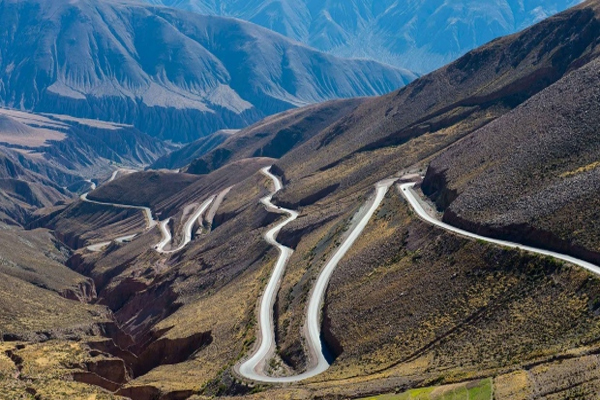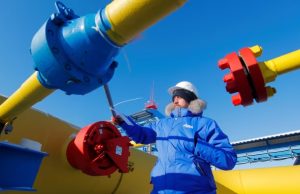
By Jonathan Gilbert, Andrew Rosati and Ethan Bronner, Bloomberg News
BUENOS AIRES/RIO/NEW YORK
EnergiesNet.com 02 18 2022
In the hinterland of Argentina, Mario Pizarro’s office looks like a shrine to China. There’s the framed photo of a Chinese peasant with Pizarro’s face superimposed beneath the conical farmer hat. There’s the blue-robed smiling Buddha statue. And there’s the model wind turbine from a Chinese company with an inscription in English and Mandarin: “Create Our Future Together.”
Pizarro, 62, is the energy secretary of Jujuy, a province high in the Andes that borders Bolivia and Chile. Overlooking a river, his office building is ordinary, shabby even, but the projects he and his colleagues oversee are anything but. And the one country that’s made them all possible is China.
Chinese technology and money have helped build one of Latin America’s largest solar energy plants in Jujuy (pronounced hu-HUY), where hundreds of thousands of panels coat the desert like giant dominoes. Chinese security cameras guard government buildings across the provincial capital. Servers hum in a Chinese data storage plant. Beneath the remote, craggy hills and vast salt lakes lie veins of copper, lithium, and zinc, the raw materials of 21st century technology—including Chinese-made electric-car batteries.
It’s no secret that China has been pouring resources into South America this century, chipping away at the U.S.’s historic dominance and making itself the continent’s No. 1 trading partner. But while international focus has turned in recent years to China’s ventures in Africa and Asia, an important shift has gone largely unnoticed in the country’s approach to South America: going local to expand and strengthen its financial grip.
Instead of focusing on national leaders, China and its companies have built relationships from the ground up. In 2019 alone, at least eight Brazilian governors and four deputy governors traveled to China. In a September 2019 speech, Zou Xiaoli, China’s ambassador to Argentina, said his country’s infrastructure push was helping weave Latin America into the global marketplace. “China will lend strong support to Argentina’s economic and social development,” he said.
As Argentina’s Jujuy province illustrates, no region is too remote for China’s scrupulous attention. With perhaps a touch of hyperbole, Gabriel Márquez, chief executive officer of a Jujuy lithium research and development center, describes the effectiveness of the approach: “You have this poor governor from Argentina who has Xi Jinping’s phone number.”
Recently the U.S. has been trying to counter China, in part by stressing the risk of buying technology from state-controlled companies that can be used for both civilian and military purposes, such as espionage. In the southern Argentine region of Patagonia, for example, a Chinese company has built a space mission control center.
Juan Gonzalez, the U.S. National Security Council’s senior director for the Western Hemisphere, says China is seeking to expand its national security footprint. “Part of our engagement is to ensure governments are making the right decisions for their own security and development,” he says.
Cynthia Arnson, director of the Latin American program at Washington’s Wilson Center, says that kind of concern won’t discourage local governments. “We must provide some alternative,” she says. “Dollar for dollar, the U.S. will never be able to match the deep pockets of Chinese investment banks.”
Consider the enthusiasm in Jujuy’s capital of San Salvador, a city of about 300,000 where pedestrians seek shelter from the subtropical heat in the shade of magnolia and rosewood trees. “A lot of government officials told me that what we were talking about, a 300-megawatt solar park, was impossible,” says Pizarro, the energy secretary. “Today it’s no longer a dream but a reality.” Of increased solar and lithium production through Chinese investment, he adds, “The sky’s the limit.”
Latin America has long been a focus of great powers. In the 15th and 16th centuries, Spain and Portugal divided the region for colonial exploitation. After national revolutions in the 19th century created independent states, Washington promulgated the Monroe Doctrine, which required European powers to consider the Western Hemisphere the U.S. sphere of influence. Well into the 1980s, Washington supported coups and sent troops into sovereign neighbors to its south.
This interference inspired anti-American resentment, creating an opening for China. Over the past two decades, as the U.S. focused on wars in Afghanistan and Iraq, China moved into the Western Hemisphere with exceptional speed, as well as financial and political muscle. Much of China’s investment began at the start of the century during the so-called pink tide, when leftist parties rose to power in Argentina, Bolivia, Brazil, Ecuador, and Venezuela.
China has bought up so much copper, pork, and soy—and constructed so many roads, trains, power grids, and bridges—that it’s surpassed the U.S. as South America’s largest trade partner and is now the single biggest trader with Brazil, Chile, and Peru. A Chinese company is leading a group that’s building the metro in the Colombian capital of Bogotá. Energy giant State Grid Corp. of China owns the company that supplies electricity to more than 10 million Brazilian homes. In February, Argentina announced that China would finance about $24 billion in infrastructure projects.
Since 2012, Chinese President Xi Jinping has visited Latin America 11 times. During his two terms, U.S. President Barack Obama was there 12; Donald Trump went once. Joe Biden didn’t visit in his first year in office.
China’s pitch: We’re here purely to do business—and to offer deals others won’t. When directed toward local officials, this approach seemed less interventionist and harder for the U.S. to counter.
The U.S. isn’t giving up. In 2019, Ivanka Trump traveled to Jujuy when she was a senior adviser to her father. A year ago the U.S. loaned Ecuador $3.5 billion to get out from under Chinese debt on the condition that it stop purchasing key technology from China. In September, Daleep Singh, a U.S. deputy national security adviser, visited Colombia, Ecuador, and Panama to promote an alternative to China’s global infrastructure-building “Belt and Road” initiative. The U.S. effort, called “Build Back Better World,” aims to offer infrastructure financing with competitive terms and in ways that promote sound environmental policy, good labor standards, and transparency.
An episode during the Trump administration shows why the U.S. will struggle to outflank China. In August 2019, just months into his tenure, São Paulo Governor João Doria, a former businessman, was looking to bring home jobs and development. So he opened his state’s first trade office abroad—in Shanghai.
Days before making a trip to China, Doria received a U.S. delegation in the governor’s mansion. Then-Secretary of Commerce Wilbur Ross implored him to shun Chinese investment, particularly in the 5G wireless network. Doria, a rival of Brazilian President Jair Bolsonaro, a Trump ally and harsh China critic, was unimpressed. “I said to him the decision was local,” Doria says. “Not a national decision, not Bolsonaro’s decision.”
The Shanghai office would lead to a victory for São Paulo: a contract with China’s Sinovac Biotech Ltd. to produce its CoronaVac vaccine—Brazil’s first and, for months, most widely used shot against Covid-19.
In early 2021, with Covid spiraling out of control and those Chinese vaccines much needed, the Bolsonaro administration signaled it wouldn’t exclude the Chinese company Huawei Technologies Co. from the 5G competition. In the end the company didn’t participate, but Brazilian operators have relied on its technology for as much as 40% of their existing networks. Banning Huawei would’ve likely sent costs soaring.
Bolsonaro at first dismissed the CoronaVac vaccine and prevented his health ministry from purchasing a million doses in October 2020 while it was undergoing clinical trials in São Paulo. “The Brazilian people WON’T BE ANYONE’S GUINEA PIG,” he tweeted. Covid deaths forced an about-face. By January last year, Bolsonaro contacted the Chinese government requesting CoronaVac shots and materials to produce other vaccines. It obliged. “China’s position is: I don’t care if your president hates me or not,” says Thiago de Aragão, head of strategy at Brazilian political consulting firm Arko Advice. “It’s extremely pragmatic.”
Mauricio Claver-Carone, president of the Inter-American Development Bank, says that China offers cheaper credit and that companies from other countries often give up on competing. Claver-Carone, a former senior Trump adviser on Latin America, also warns of national security risks: “The last thing countries need is to become reliant on secretive contracts and nontransparent actors like Chinese state-owned companies.”
Such concerns are a “rich-world problem,” says Oliver Stuenkel, a professor of international relations at the Getulio Vargas Foundation in São Paulo. “You really can’t have the luxury of thinking about potential negative outcomes down the road if you have to face a very urgent problem right in front of you.”
When China began focusing on Latin America, Jujuy was ready. In the 1990s, Argentina had overhauled its constitution and granted provinces greater leeway to guide their economies and forge international ties. Jujuy, 900 miles from the Argentine capital of Buenos Aires, began to cut loose from the central government and sought to manage its own relations with neighbors in Argentina, as well as in Chile and Bolivia.
The region, about the size of West Virginia, remains one of Argentina’s poorest, known mostly for the tobacco and sugar farms dotting its hillsides. Yet Jujuy, which has a population of 770,000, has some key advantages. Miners can extract lithium from its bright-white, high-altitude salt flats more easily than in Bolivia or Chile. It’s also situated in a prime crossroads. The road that climbs up to the Chinese-built solar plant, Cauchari, continues west, crossing the Andes to Chile and reaching the Pacific coast. To the east, Jujuy links Argentina to Paraguay, and then to Brazil.
With initial help from Germany, Jujuy developed small solar projects in the early 2000s, around the time Chinese demand for lithium was starting to increase, according to Alejandro Safarov, dean of international relations at the Jujuy campus of the Catholic University of Santiago del Estero. “When China changed its geopolitics, Jujuy really began to open its mind up,” says Safarov over a lunch of fried beef empanadas and humitas, a corn dough boiled in the plant’s husks, a regional specialty.
By 2014, a year after Xi unveiled China’s “Belt and Road” initiative, Jujuy’s government opened its first foreign office. Two years later, Pizarro, the energy secretary, traveled to China with the delegation that negotiated a $330 million loan for Cauchari. China’s state import-export bank offered a rate of 3% when Western peers were demanding about 8%. The plant began producing electricity in 2020. Local leaders have an ambitious goal of ultimately tripling its capacity, to 1,000 megawatts, which would make it one of the world’s biggest solar plants.
Pizarro, like his regional governor, has been to China several times. A notary by training, Pizarro, who wears black-framed glasses and speaks with a distinct northern Argentine accent, likes to get things done. He’s using revenue from solar power to finance schools for Indigenous people while respecting what those groups call la Pachamama, or Mother Earth.
It’s extraordinary that a province in Argentina can have international ambitions at all. In 2020 its federal government defaulted on the bonds it sold to Wall Street, and it still owes tens of billions of dollars to the International Monetary Fund. “Argentina’s economy is so calamitous that only adventurers like China can do business here,” says Carlos Oehler, who ran the provincial energy and mining company Jemse. He also met with five Chinese delegations interested in Jujuy’s lithium salt flats and magnesium deposits. “Jujuy is starting to dream of being an independent global player,” he says.
Jujuy is home to an Australian-Japanese venture that became Argentina’s second lithium producer in 2015. Minera Exar, majority-owned by giant Chinese battery company Ganfeng, is set to become the third this year as bidding wars heat up among China and other countries to develop lithium deposits found across northwestern Argentina.
The province is making sure it gets a return by taking an 8.5% ownership stake in lithium mines. Jemse is in talks for new projects with suitors from China, Australia, and Canada, says company President Felipe Albornoz. Provincial officials are also pushing companies such as Ganfeng to open battery-parts factories in Jujuy rather than ship materials to Asia.
The contrast between Jujuy’s past and present is striking. The province is building a hub to spur lithium-related manufacturing right outside San Salvador, in the dying steel town of Palpala. New, shiny warehouses sit on overgrown land, in the shadow of the rusting steelworks and its cracked cooling tower.
Back in the capital city, on a recent weekday, vendors hawked bric-a-brac out of stalls by an old bus terminal. The new foreign influence seemed to both bemuse and worry them. “At this rate we’re all going to become Chinese,” says Mirtha Ramos, a 49-year-old mother of three who was selling fake designer caps. Nancy Ortega, 31, working at the next stall, adds, “I have a friend up in the mines who said the Chinese are taking over everything.” —With Jennifer Jacobs and Eric Martin
Gilbert reports on commodities and energy in Buenos Aires, Rosati covers Brazil’s economy from Rio de Janeiro, and Bronner is a senior editor in New York.
bloomberg.com 02 17 2022












